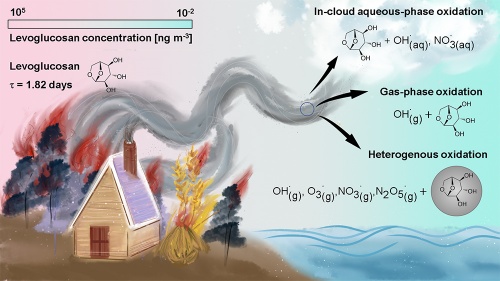Difference between revisions of "Papers:Li et al 2021"
From atmoschem
(Created page with "'''Abstract |''' We used the GEOS-Chem model and its adjoint to quantify Chinese non-methane volatile organic compound (NMVOC) emissions for the year 2007, using the troposphe...") |
Atomoschem (Talk | contribs) |
||
| (2 intermediate revisions by one other user not shown) | |||
| Line 1: | Line 1: | ||
| − | + | [[Image:levoglucosan.jpg|center|500px|Chemical degradation of levoglucosan in the atmosphere.]] | |
| + | '''Abstract |''' Levoglucosan has been widely used to quantitatively assess biomass burning’s contribution to ambient aerosols, but previous such assessments have not accounted for levoglucosan’s degradation in the atmosphere. We develop the first global simulation of atmospheric levoglucosan, explicitly accounting for its chemical degradation, to evaluate the impacts on levoglucosan’s use in quantitative aerosol source apportionment. Levoglucosan is emitted into the atmosphere from the burning of plant matter in open fires (1.7 Tg yr–1) and as biofuels (2.1 Tg yr–1). Sinks of atmospheric levoglucosan include aqueous-phase oxidation (2.9 Tg yr–1), heterogeneous oxidation (0.16 Tg yr–1), gas-phase oxidation (1.4 × 10–4 Tg yr–1), and dry and wet deposition (0.27 and 0.43 Tg yr –1). The global atmospheric burden of levoglucosan is 19 Gg with a lifetime of 1.8 days. Observations show a sharp decline in levoglucosan’s concentrations and its relative abundance to organic carbon aerosol (OC) and particulate K+ from near-source to remote sites. We show that such features can only be reproduced when levoglucosan’s chemical degradation is included in the model. Using model results, we develop statistical parametrizations to account for the atmospheric degradation in levoglucosan measurements, improving their use for quantitative aerosol source apportionment. | ||
| − | '''Publication |''' '''Li, Y.''', '''Fu, T.-M.*''', Yu, J. Z.*, '''Xu, F.''', '''Zhang, L.''', Chen, J., Boreddy, S. K. R., Kawamura, K., Fu, P., Yang, X., Zhu, L., Zeng, Z. (2021), Impacts of chemical degradation on the global budget of atmospheric levoglucosan and its use as a biomass burning tracer, ''Environmental Science & Technology'', 55(8), 5525-5536, doi:10.1021/acs.est.0c07313. [https:// | + | |
| + | '''Publication |''' '''Li, Y.''', '''Fu, T.-M.*''', Yu, J. Z.*, '''Xu, F.''', '''Zhang, L.''', Chen, J., Boreddy, S. K. R., Kawamura, K., Fu, P., Yang, X., Zhu, L., Zeng, Z. (2021), Impacts of chemical degradation on the global budget of atmospheric levoglucosan and its use as a biomass burning tracer, ''Environmental Science & Technology'', 55(8), 5525-5536, doi:10.1021/acs.est.0c07313. [https://atmoschem.org.cn/papers/li_et_al_2021_Environmental_Science_and_Technology.pdf PDF ] [https://doi.org/10.1021/acs.est.0c07313 Full text]. | ||
Latest revision as of 14:49, 8 October 2023
Abstract | Levoglucosan has been widely used to quantitatively assess biomass burning’s contribution to ambient aerosols, but previous such assessments have not accounted for levoglucosan’s degradation in the atmosphere. We develop the first global simulation of atmospheric levoglucosan, explicitly accounting for its chemical degradation, to evaluate the impacts on levoglucosan’s use in quantitative aerosol source apportionment. Levoglucosan is emitted into the atmosphere from the burning of plant matter in open fires (1.7 Tg yr–1) and as biofuels (2.1 Tg yr–1). Sinks of atmospheric levoglucosan include aqueous-phase oxidation (2.9 Tg yr–1), heterogeneous oxidation (0.16 Tg yr–1), gas-phase oxidation (1.4 × 10–4 Tg yr–1), and dry and wet deposition (0.27 and 0.43 Tg yr –1). The global atmospheric burden of levoglucosan is 19 Gg with a lifetime of 1.8 days. Observations show a sharp decline in levoglucosan’s concentrations and its relative abundance to organic carbon aerosol (OC) and particulate K+ from near-source to remote sites. We show that such features can only be reproduced when levoglucosan’s chemical degradation is included in the model. Using model results, we develop statistical parametrizations to account for the atmospheric degradation in levoglucosan measurements, improving their use for quantitative aerosol source apportionment.
Publication | Li, Y., Fu, T.-M.*, Yu, J. Z.*, Xu, F., Zhang, L., Chen, J., Boreddy, S. K. R., Kawamura, K., Fu, P., Yang, X., Zhu, L., Zeng, Z. (2021), Impacts of chemical degradation on the global budget of atmospheric levoglucosan and its use as a biomass burning tracer, Environmental Science & Technology, 55(8), 5525-5536, doi:10.1021/acs.est.0c07313. PDF Full text.
- This page was last modified on 8 October 2023, at 14:49.
- This page has been accessed 1,323 times.
